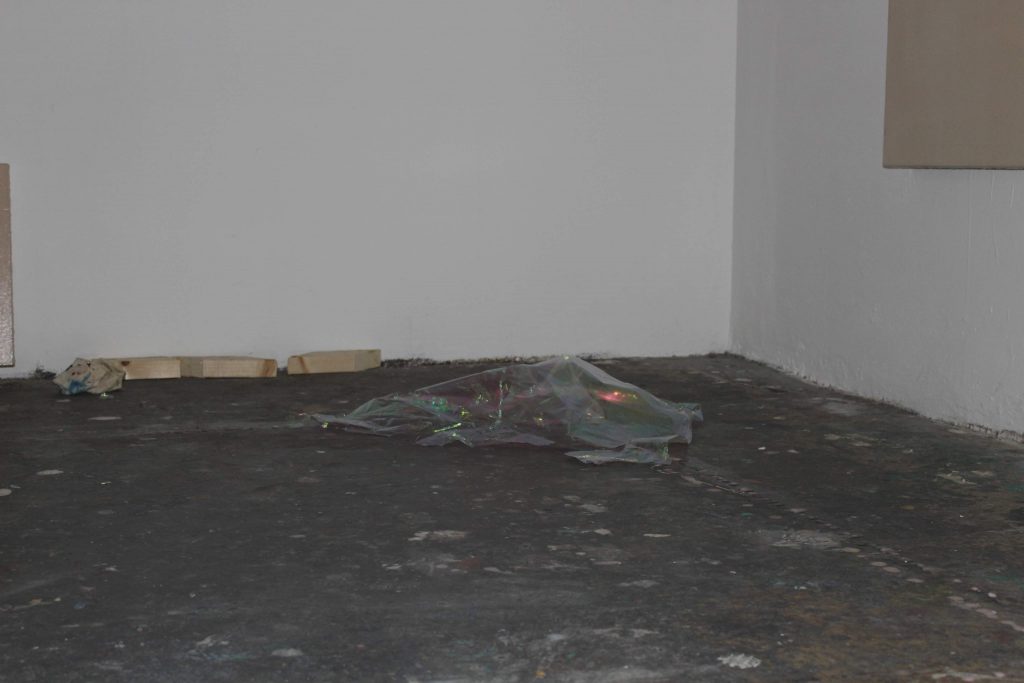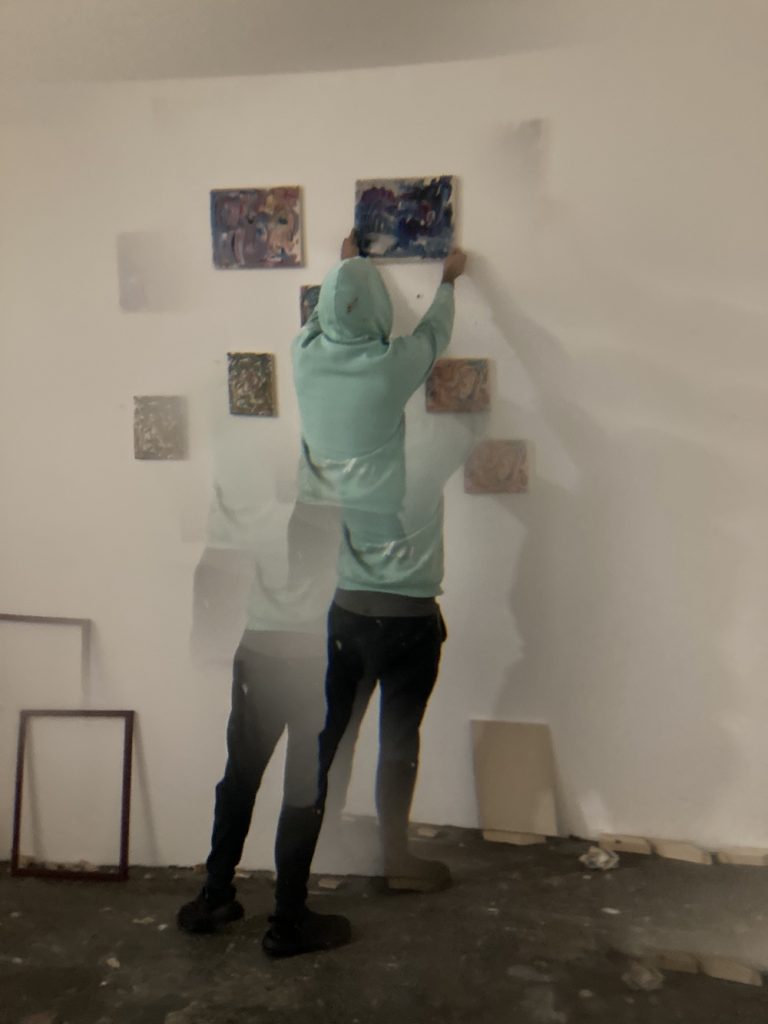Virtual Studio Visit with Jesús Crespo
by Ilaria Sponda
Jesús Crespo is a visual artist from Madrid, currently based in London. His work thrives on the energy put into the artistic gesture and the relationship between the metamorphosis, dissolution and extrapolation of images. Ambiguity is a constant in his paintings: a territory where painting becomes transformative and performative, never fixed, yet always in the process of becoming.
Jesús finished his studies in London, at Camberwell College of Arts, in 2016 and holds an MA in Investigation, Art and Creation from Universidad Complutense de Madrid. His work has been exhibited in different cities such as London, Lisbon, Paris, Madrid, Barcelona, and Antwerp.
He is currently part of the Turps Studio Programme in London — a year-long studio and mentorship program for painters. Ilaria Sponda took a virtual visit to his studio there to talk about the program, his current research on liquidity, his ideal work environment, and more.

Ilaria Sponda: Hi Jesús, thank you so much for this virtual studio visit. Could you tell us a bit about Turps and what it is for you?
Jesús Crespo: Turps Studio Programme is an opportunity for painters in South London, where I’m currently developing my practice. They provide painters with a shared studio and a very dynamic programme of crits, talks, mentoring sessions, and not only with the aim to discuss and question painting. For me is a place where painters have their own voice and space to relate to important issues about the practice of painting. I got to know them five years ago when I was finishing my studies as an Erasmus student at the Camberwell College of Arts. I went to an exhibition organised by Turps and I fell in love with them. Coming from Madrid, where there weren’t many opportunities for emerging painters and painting didn’t get any attention, it was really satisfying to discover a place in a different context made by painters for painters. Indeed, I was born in Madrid and grew up there and experienced a lack of places for emerging painters. It was only after the pandemic that a couple of project spaces interested in emerging painters appeared, like El Chico and Arniches26.
Going back to Turps, from the moment I discovered it I knew I wanted to apply and participate in their Studio Program. Even though Brexit doesn’t make it easy for a foreigner to live in London and deal with all the bureaucracy, I applied and accepted the challenge. I’m an artist that lives with and, better said, for challenges. My paintings are kind of challenges themselves. The Studio Programme that I’m part of offers a dynamic network I can connect with. It is a place where I can grow and experiment while developing my career, as well as professionalising it.

IS: Are you currently working on a particular project?
JC: Since my first residency at PADA in Lisbon and the following one at Ladrón de Guevara in Guadalajara (México), I’ve been developing my own research on liquidity, wetness and the fluid appearance of paint. I’m focusing on the meaning of painting and the aesthetic properties of materials to talk about art itself in a metalinguistic way. What is the meaning of painting? What is the meaning of meaning? To work with wetness, and slippery surfaces through an almost sexual approach to the painting and the surface means to play with the very nature of the creative value of my paintings. The forms that come out of this seem comfortable in the “still wet” atmosphere that I make for them.
A nice metaphor is the creation of plants, fungi or bacteria, or even the gestation of a living being, which happens in wet environments. Likewise, my paintings are created in wetness, are in the process of becoming and alive. I leave my images, my paintings in that liminal state where people can see something in the making and growing. The wetness in the painting is important to give a sense of fluidity. Dryness means to me the last state of something, the end of something, while wetness means that something is still open to be processed.
IS: Ambiguity and undefined forms are a constant in your works. How do you relate yourself to abstract painting and how do you depart from it to build your own approach and language?
JC: People can see different things in my images. Indeed, I use abstract elements to construct images that are not abstract at all. I’m not interested in abstract expressionism and I’m not interested in figurative painting either. I’m only using some tools of both because they help me to focus and live the process of painting. You can see that my paintings are finished because they work as paintings. Every painting is a challenge and discussion between me and the painting itself.
I approach my art in an intense way. I always draw a parallel between my art and sexual acts because the former is very much like the latter: they are ways to create something based on love or attraction, they’re intense and wet and they’re mediums to create something as we are. I’m currently developing works with lubricated surfaces, for example. The surfaces end up being shiny as if they were covered in saliva, vaginal fluids or semen. It is important for my canvases to be lubricated and ready for my art to appear in the moment. I work with oil colours and vinyl resin to fix my paintings and I always make a transparent film between the paint and the fabrics I work on. Colours never penetrate the fabric. They stay on the surface and that stands as a statement of what I’m doing, something tragicomic, and frustrating as well.. like the emptiness that remains after a sublime feeling.

IS: What is your creative process like?
JC: It is like a trance. This is why I have to finish a painting in a single session. I could spend a week preparing my canvas – as it takes time – but the action of painting has to be condensed into a single moment, which could last for a maximum of three hours. I always paint at night, when I can be in trance and be focused. My paintings show the processuality of their creation. I try to avoid all the images that I know I can paint. I never have in mind how my painting should look. If I do, I don’t paint it. I need to paint something that I don’t know and I’ve never seen. I only know what I don’t want, which is risky.
I try to compose my images with what’s happening at the moment I paint. This is why liquidity is important for me: to find an image. I could start with an idea about the colours I want to use. Everything happens on the surface. In the end, I see colours and juxtaposition that I’ve never thought of. I avoid things that I know I can do or that I’m not interested in. The process is about finding a balance between what the painting wants and what I want. That is why I refer to my paintings as discussions.

IS: Do you feel like the different environments you work in have an impact on your artworks? How much of them is visible in your paintings?
JC: I’m sure about it, even though I’m not a painter that directly brings it to the canvas, at least not on purpose. It’s a hard question to answer. Maybe it’s more the conditions that I work in that get transposed on my paintings. My work is very physical, it is like body painting. Consequently, the environment always brings my body to be in different moods. No matter where I am, I’m always trying to express the same things. It is true though, that in some places my paintings result in being more colourful and vibrant, or darker and more mysterious. That can happen, but it’s not something conscious. I think, in the end, the place I work in does come across my body.
At this point in my career, I want to experience different places and travel but that is not something that informs my paintings. I like the environment to impact me, but not in a conscious way. I think it’s a good question to ask every artist. If you gave me the chance to be in the perfect place to work I’d maybe pick a place in particular, for example, Sintra (Lisbon). It would be amazing to practice there, especially in one of the Castelo da Pena’s towers. I would love to choose a perfect place to work with respect to how I feel there and what I could aesthetically experience there, but at the moment, I’d rather give priority to places where there are many opportunities.

Ilaria Sponda is an interdependent curator, writer and visual artist based in Dublin. With an educational background in Arts, Media and Cultural Events (IULM, Milan) and Management of the Arts and Culture (UCP, Lisbon), she also chose photography as a medium to bring about her personal artistic research.
Sponda’s curatorial research is inspired by artists that engage with the camera and other media as anthropologists of contemporary society, both on an individual and collective level. Her current research is based in the image culture and how it is affected by global circulations. Within this context, she looks to deconstruct contemporary curating towards a critical mediation of art and its understanding.